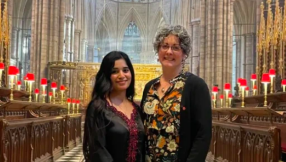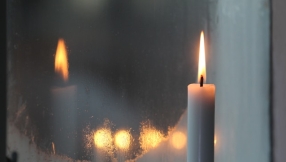
What does the word 'pilgrim' mean to you?
To me at school it meant Chaucer's Canterbury Tales. More especially, it meant the character of the Prioress, who chose to amuse the company on their pilgrim route to the shrine of Thomas à Becket by regaling them with the worst Jewish blood libel myth in English history.
Incidentally, Becket was murdered by fellow Christians in the Cathedral in 1170, just before the York massacre of Jews which took place in 1190.
By 1290, the Jews had been thrown out of England (many were deliberately drowned in the Wash). Therefore, there were not even any Jews living in England at the time of the Canterbury Tales. And, yet, this Tale is still told to school children everywhere as one of the finest examples of English literature.
Equally disturbing in the Middle Ages was the frequent assimilation of crusade to pilgrimage, a real corruption of the pilgrimage idea and a repeated historical occurrence whose repercussions are still with us.
Then, the second important school reference to pilgrimage was the religious allegory, John Bunyan's Pilgrim's Progess, written in 1678. What made a particularly deep impact was Bunyan's powerful phrase depicting rock bottom - a place he calls the 'Slough of Despond'.
And in history, we learned about 'The Pilgrim Fathers' who left these shores in 1620, making for their own Promised Land of the Americas – and some of them even learned Hebrew, and some also espoused Jewish values.
But, what was the original type of pilgrimage? I first realized what pilgrimage really meant in 2004, and in most unexpected circumstances.
In 2004, the Dalai Lama was honoured in Liverpool's Anglican Cathedral, probably the largest such building in Europe, when he told the Dean, 'You could learn a great deal from the Jewish people, who have taught the world a great deal about the meaning of pilgrimage. I've just come back from my own pilgrimage to Jerusalem together with Jewish, Buddhist and Christian friends, and we learned a lot. The answer is to go on pilgrimages together – and especially to Jerusalem. You should try it, Dean. You might learn a thing or two!''
You could have heard a pin drop.
It is true: the first pilgrims were not Christian, as is generally thought - they were Jews – and their main object of pilgrimage was the Holy Temple. This was built by King Solomon in Jerusalem around 3,000 years ago and has always remained in Jewish souls even after it was first destroyed in around 586 BCE, rebuilt approximately 70 years later, and then destroyed once again by the Romans in 70 CE.
This destructive event gladdened the hearts of the Roman pagans and may not have disturbed the early Christians too much because they believed that the Temple had been replaced by the person of Jesus.
Yet, as well as a remnant of the Jewish people, there is a remnant of the Temple known as the Kotel (Western Wall) that has always remained – even though under the British Mandate (1920 - 47) Jews were arrested and imprisoned for meeting there - and since the reunification of Jerusalem in 1967, the Kotel has become a place of huge pilgrimage.
Jews have always known, therefore, the meaning of pilgrimage, which in Hebrew translates as 'going [up] on foot'. The walking was as important as the arriving and provided time for the individual to prepare him or herself for the eventual meeting with G-d in divine service and sacrifice. Nothing like the Canterbury Tales, then.
To be honest, it hasn't always been clear what other pilgrimages are for. The Japanese tourists who used to knock on my door in Liverpool, asking the way to John Lennon's home, for instance, may have been armed with their cameras – but their visit wasn't simply tourism.
And when in 1989 all Liverpudlians were wrongly blamed by police and media for the Hillsborough football disaster, I felt as aggrieved as any of them. After all, Liverpool was full of wonderful people, and no more drunk or disorderly than anywhere else, in my experience. And, in our own time, isn't a football match often a type of contemporary pilgrimage, after all?
And so, we come to the present Jewish festival period, between Pesach and Shavuot, when Jews all over the world count the Omer, and prepare for the receiving of the Torah on Sinai. For many, the first 33 days of this 49-day period is one of semi-mourning. And on the 33<sup>rd day, known as 'Lag Be'Omer', people rejoice. They build bonfires, have their hair cut, get married and concentrate on the final 16 days which lead to the festival of Shavuot. This culminates in the giving of the Torah to all the Jewish people by G-d via Moses at Sinai. I've written about last year's festival here.
And increasingly in Israel, the tiny hamlet of Meron (population under 1,000), the northern burial site of the founders of the two most famous Jewish religious schools, dating back 2,000 years, the Schools of Hillel and Shammai, has become a place of pilgrimage in its own right.
Plus, Meron also contains the grave of Rabbi Shimeon bar Yochai, who escaped from the Romans and hid there, whilst reputedly writing the holy kabbalistic text known as the Zohar. For on this day of Lag Be'Omer 1,900 years ago, the plague that had afflicted the students of Rabbi Akiba suddenly stopped and people were able to take up their lives as normal once again.
And it was all these things that were being celebrated this year on Lag Be'Omer in Meron, when disaster struck. We all know someone who was affected. Today, I spoke to the sister of the young man from this area of Greater Manchester who was killed in the crush – I didn't even know her but felt that I had to be in touch. That could have been my own daughter, who was staying in nearby Zfat (Safed) and might very well have made the very short journey herself.
For, in spite of news reports to the contrary, not everyone attending the Lag Be'Omer celebrations was necessarily Hasidic, Haredi, or even Orthodox. The annual pilgrimage to Meron is open to all Jews, many of whom were enjoying a break in the general mourning period, and who were simply attending a revered spot in northern Galilee which they were unable to do last year because of Covid conditions. And a fair few were foreign pilgrims.
But, just as at Hillsborough, blame has already been apportioned without all the facts being known. And it might take a very long time to assess exactly how the 'avalanche' started.
I visited Meron once. It was in the spring of 1984 and I found two small caves lit with candles, articles of clothing, and letters of imprecation to a number of revered rabbis.
I also visited the nearby Palm Tree of Deborah, the Prophetess – and sat under it, trying to feel what it must have been like for her in the days of the Judges, when she had to save her people from the enemy.
Then there was Bet-El, near Jericho, where Jacob had dreamed his famous ladder dream. Here, the local Christian Arabs came out to welcome us and relate the secret of the sacred spring nearby which, it's reputed, is the reason the place is constantly green and fertile.
As for all those places in Europe where our greatest medieval Jewish commentators lived and worked, I've visited many of those as well – visited and marveled.
But, after all these visits, I still think that personal preparation is crucial. If pilgrims are simply a motley crew of dissatisfied hangers-on, bent on letting off steam, or getting rid of pent-up energy, as depicted in the Canterbury Tales, then they might as well stay home, or maybe go down the pub.
But if, as in Judaism, the walking is part of the process of coming nearer to the divine, then Jerusalem and Meron will continue to act as magnets. These revered locations will go on attracting Jewish pilgrims of all kinds and from all over the world.
Because the aim of these pilgrims has always remained constant – to experience the togetherness of 14 million people with a shared history – and to reenact and remember as one body those early days between Egypt and Sinai, when at the beginning of our history the entire Jewish community, great and small, walked together to experience the epiphany at Sinai – which is, after all, why they had been freed from slavery in the first place.
Dr Irene Lancaster is a Jewish academic, author and translator who has established university courses on Jewish history, Jewish studies and the Hebrew Bible. She trained as a teacher in modern Languages and Religious Education.













